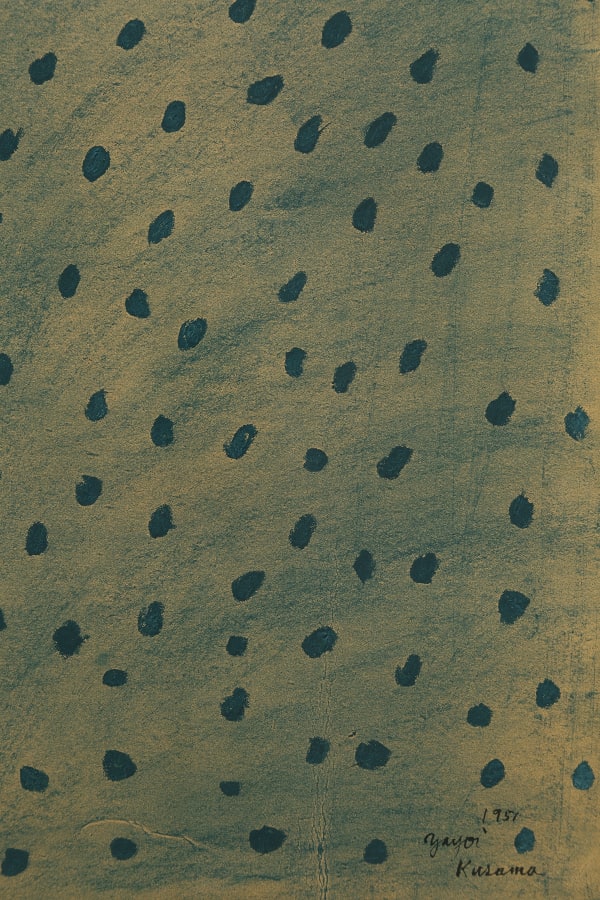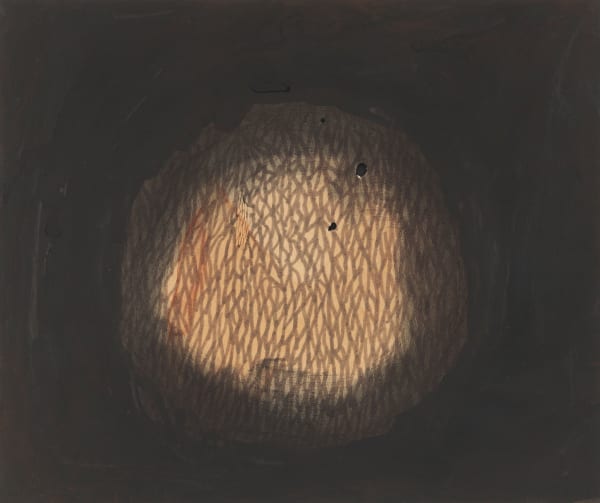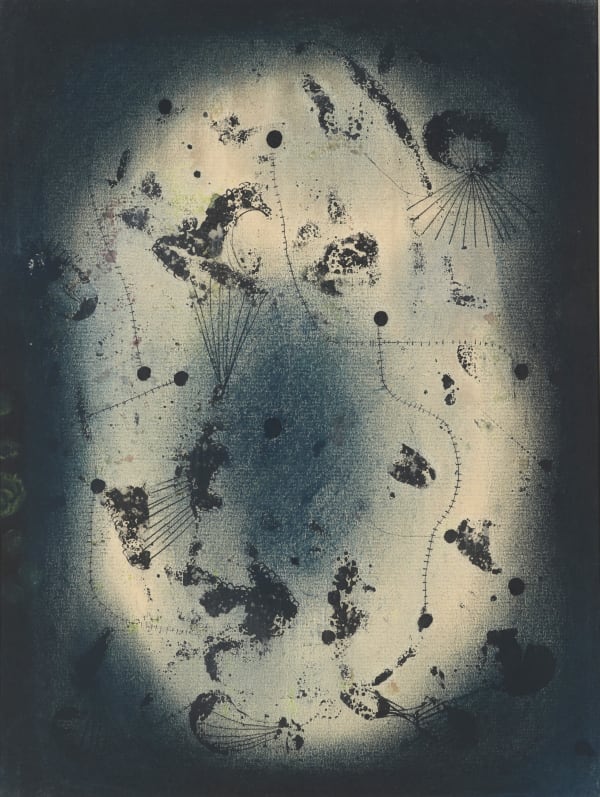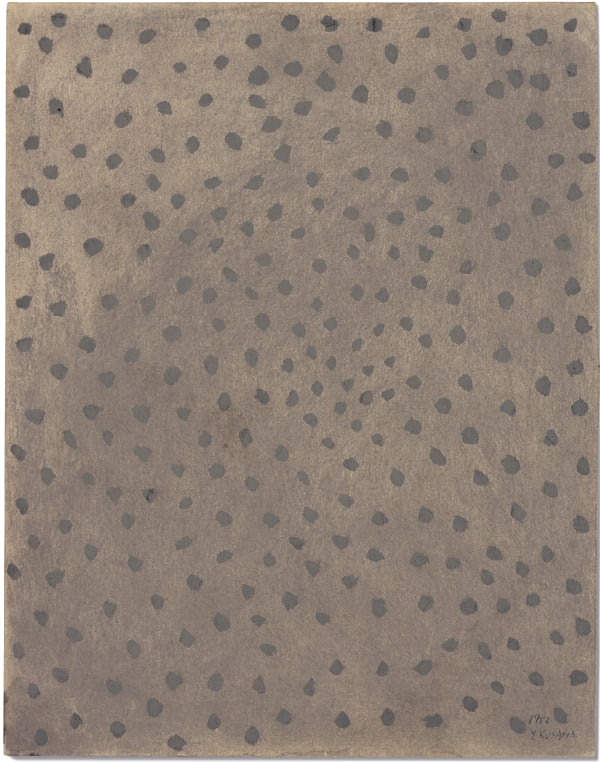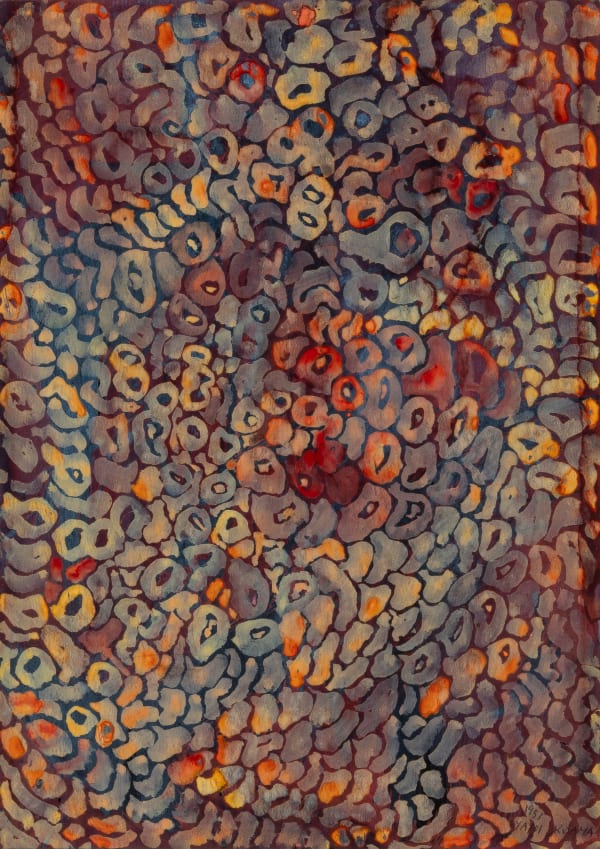Yayoi Kusama: Early Works on Paper
Omer Tiroche Gallery is pleased to announce our forthcoming exhibition, Yayoi Kusama: Early Works on Paper. The featured works explore the formative years of Kusama's creative journey, delving into the early stages of her artistic development. This exhibition examines how Kusama's initial explorations on paper laid the groundwork for the distinctive motifs and themes that would define her later and much-celebrated works.
Kusama was born in 1929, in Matsumoto, Japan, to a wealthy merchant family known for their technologically advanced wholesale plant farm and seed nursery. In spite of their affluence, Kusama's childhood was marked by turmoil; her parents' marriage was fraught with conflict due to her father’s flamboyant extramarital affairs. This instability profoundly affected Kusama, leading to a strained relationship with her mother, who was both physically and mentally abusive, and vehemently opposed her becoming an artist.
Kusama began experiencing hallucinations at age 12, including seeing auras around objects and hearing speech from flowers and animals. Plagued by these daily visions and hallucinations, Kusama would eventually suffer from severe distortions of reality during what she called her "era of mental breakdown". She began treatments and, encouraged by her doctor, turned to art to express her anxieties and visions, rendering otherworldly, cosmic forms and patterns in delicate ink and gouaches.
Kusama’s early works are a testament to her exploration of repetition and dots, which became defining features of her artistic identity. Known as the "Polka Dot Princess," Kusama used dots not only as a visual motif but also as a philosophical statement, representing infinity, self-obliteration, and the sublime. This exploration began as early as 1939 with a portrait of her mother, where the image is obscured by dots, hinting at a desire to merge the self with the universe. The theme is further developed in works like Incomplete Proliferation No. 81, 1951, where the obsessive repetition of dots creates a hypnotic, immersive environment that draws viewers into a meditative state. Similarly, Kusama's Infinity Nets series showcases her preoccupation with pattern, as the nets extend infinitely, mirroring her psychological state, as in Island 55 from 1955.
In parallel, Kusama’s early works also showcase her deep fascination with light and the natural world, creating a rich tapestry of motifs that blend the familiar with the fantastical. Growing up in rural Japan surrounded by plants, insects, and agriculture, she was deeply inspired by the flora and fauna around her. This inspiration is evident in works such as Untitled, 1953, where delicate markings resemble microorganisms, creating intricate and otherworldly scenes. Her surrealist tendencies emerge in The Configuration of Desire, 1954, blending trees and ethereal forms to create an uncanny natural world. Kusama’s mastery extends to her depiction of light, a crucial element in her artistic language.
Although she attended art school for only one year and lacked formal training in chiaroscuro, she skilfully manipulated light and shadow to evoke emotion, as seen in The Woman, 1953, where an ominous figure emerges from the darkness. Her innovative use of colour is evident in works like Days, 1953, where coloured tips on nets suggest movement and life, foreshadowing her later exploration in her Infinity Mirror Rooms, where mirrors and lights create illusions of infinite space.
Created in the early 1950s, before her move to the United States, Kusama's prolific output showcases her intense psychological exploration and inventive approach to form and light, seeking to transcend the physical world's limitations. These intimate works, devoid of the Western influences she would later encounter, represent a pure expression of her unique vision. In 1957, before embarking on her transformative journey to the U.S., Kusama destroyed much of her earlier work in a dramatic act of renewal. As a result, the surviving pieces serve as a significant and invaluable time capsule of her early, unfiltered creativity.
Yayoi Kusama is one of the most celebrated living artists, known for her visionary contributions to contemporary art. Her signature polka dot and Infinity Net paintings revolutionised traditional painting and influenced minimalism and conceptual art. Her immersive Infinity Rooms redefined installation art, while her provocative "happenings" and performance art of the 1960s pushed social boundaries, contributing to the rise of performance art. Engaging with themes of identity, gender, and race, her work resonated with feminist and countercultural movements. Despite her mental health struggles, Kusama’s creativity and innovation across multiple mediums have made her an enduring icon of contemporary art and culture.
-
 Yayoi KusamaAutumn, 1952Pastel and ink on paper26.4 x 18.6 cm.
Yayoi KusamaAutumn, 1952Pastel and ink on paper26.4 x 18.6 cm.
10 ⅜ x 7 5/16 in. -
![Yayoi Kusama I land [Island] in Night (No 2), 1953 Watercolour and pastel on paper 25 x 34.3 cm 9 7/8 x 13 1/2 in](data:image/gif;base64,R0lGODlhAQABAIAAAAAAAP///yH5BAEAAAAALAAAAAABAAEAAAIBRAA7) Yayoi KusamaI land [Island] in Night (No 2), 1953Watercolour and pastel on paper25 x 34.3 cm
Yayoi KusamaI land [Island] in Night (No 2), 1953Watercolour and pastel on paper25 x 34.3 cm
9 7/8 x 13 1/2 in -
 Yayoi KusamaIncomplete Proliferation No. 81, 1951Ink and pastel on paper43 x 30 cm.
Yayoi KusamaIncomplete Proliferation No. 81, 1951Ink and pastel on paper43 x 30 cm.
16 15/16 x 11 13/16 in. -
 Yayoi KusamaNo. 2 Light, 1962Watercolour, gouache, pastel, felt tip pen, and ink on paper29.8 x 36.8 cm.
Yayoi KusamaNo. 2 Light, 1962Watercolour, gouache, pastel, felt tip pen, and ink on paper29.8 x 36.8 cm.
11 ¾ x 14 ½ in.
-
 Yayoi KusamaThe Castle, 1954Ink, pastel and gouache on paper24.6 x 17.8 cm.
Yayoi KusamaThe Castle, 1954Ink, pastel and gouache on paper24.6 x 17.8 cm.
9 11/16 x 7 in. -
 Yayoi KusamaUntitled, 1953Watercolour, gouache, pastel and ink on paper29.8 x 22.9 cm.
Yayoi KusamaUntitled, 1953Watercolour, gouache, pastel and ink on paper29.8 x 22.9 cm.
11 ¾ x 9 in. -
 Yayoi KusamaUntitled, 1953Pastel and gouache on paper34.5 x 39.4 cm.
Yayoi KusamaUntitled, 1953Pastel and gouache on paper34.5 x 39.4 cm.
13 4/7 x 15 1/2 in.$ 300,000.00 -
 Yayoi KusamaUntitled, 1952Gouache and pastel on paper38 x 30 cm.
Yayoi KusamaUntitled, 1952Gouache and pastel on paper38 x 30 cm.
15 x 11¾ in.
-
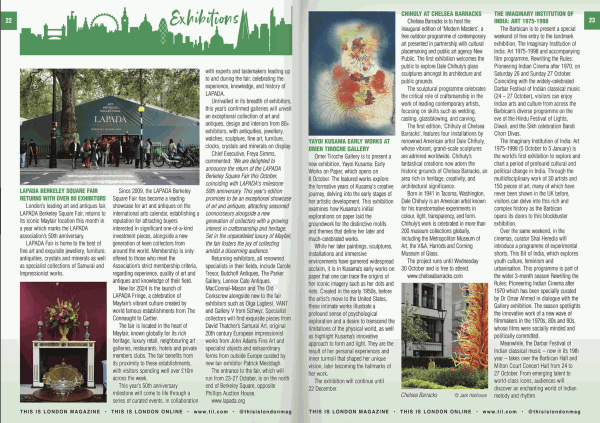
Exhibitions
This Is London, October 1, 2024













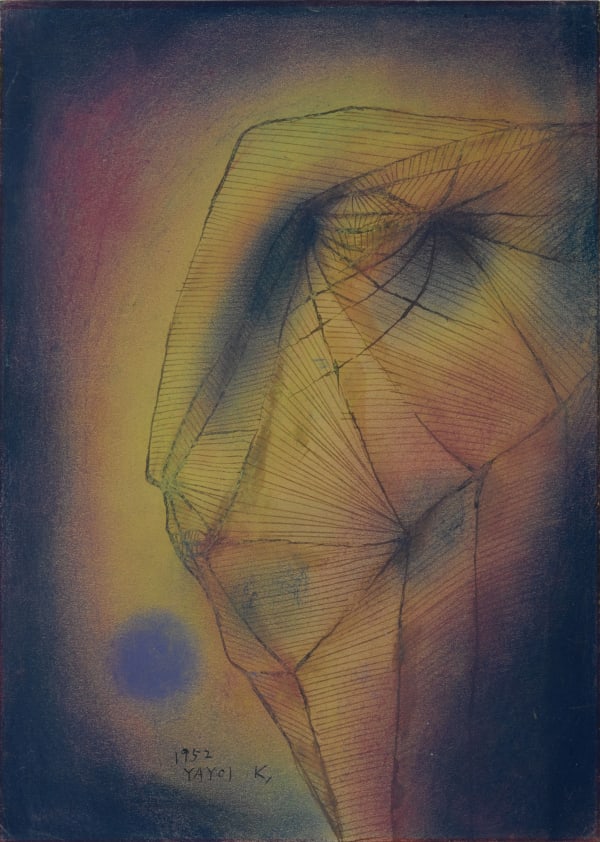
![Yayoi Kusama I land [Island] in Night (No 2), 1953 Watercolour and pastel on paper 25 x 34.3 cm 9 7/8 x 13 1/2 in](https://artlogic-res.cloudinary.com/w_600,c_limit,f_auto,fl_lossy,q_auto/artlogicstorage/leonardo/images/view/768d2edffb2b9cc5d0e769d0a98f2bcfj/omertirochegallery-yayoi-kusama-i-land-island-in-night-no-2-1953.jpg)
